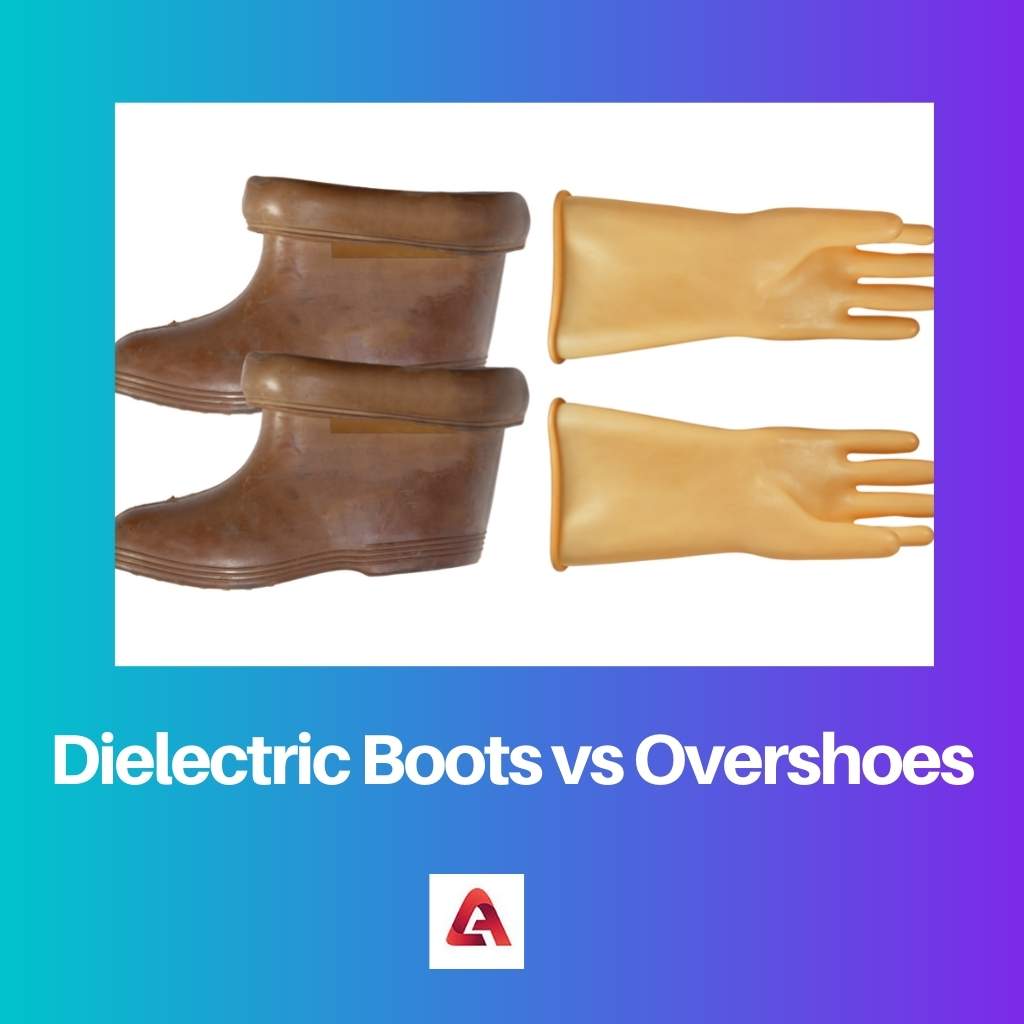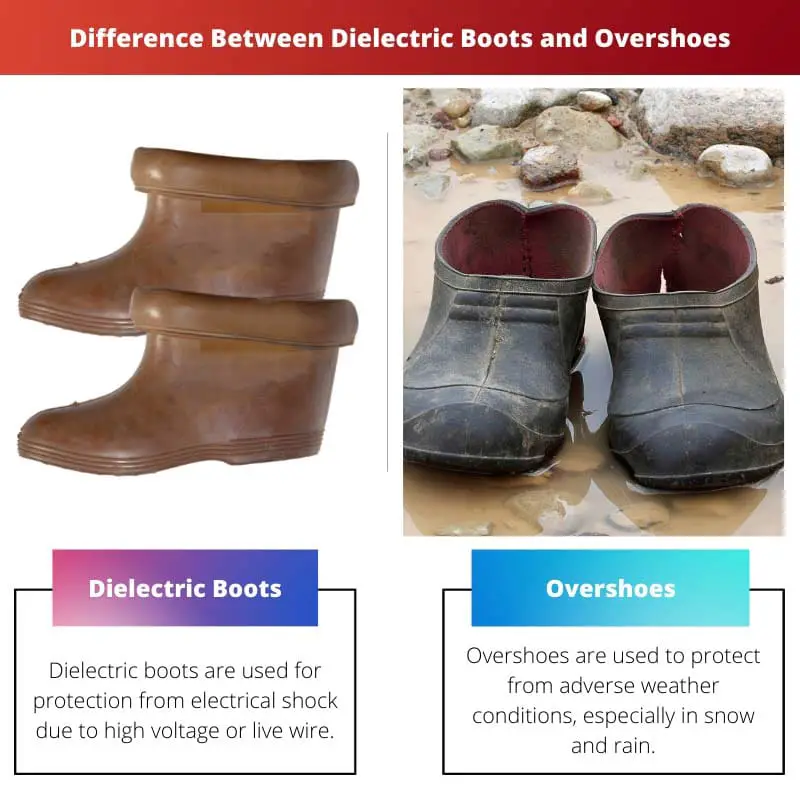Dielectric boots and overshoes are both used as prevention methods in different circumstances. However, adhering to the guidelines in the areas where accidents may happen is very important.
Key Takeaways
- Dielectric boots provide electrical insulation and protection for workers, while overshoes slip over regular footwear to offer additional safety features.
- Dielectric boots meet specific safety standards and prevent electrical shocks, while overshoes offer varying degrees of protection depending on the design.
- Both options safeguard workers in hazardous environments, but dielectric boots offer specialized electrical insulation, while overshoes enhance existing footwear.
Dielectric Boots vs Overshoes
Dielectric boots are boots that are worn where there is a risk of electric shock from a high voltage, and they provide insulating properties to stop electric current. Overshoes are a type of shoe that is worn over a normal shoe, made of rubber to protect the normal shoe or the floor surface.

Boots are made from vulcanized rubber and an inbuilt steel toe cap. Their significant purpose is to protect from electric shocks, however, they also offer high slip resistance.
Overshoes are shoes composed of rubber used during rain or snow to prevent them from slipping. However, cyclists also wear it to keep them from rain and wind.
Comparison Table
| Parameters of comparison | Dielectric Boots | Overshoes |
|---|---|---|
| Purpose | Dielectric boots are used for protection from electrical shock due to high voltage or live wire. | Overshoes are used to protect from adverse weather conditions, especially in snow and rain. |
| Electric insulation | It has electric insulation. | Overshoes don’t have electrical insulation. |
| Inbuilt steel toe protection | Dielectric boots have inbuilt steel toe protection. | It doesn’t have. |
| Wearable | Dielectric boots are directly worn over feet. | Overshoes are worn over regular shoes. |
| Other features | Dielectric boots may have additional shin protection, cleats, ankle protection, slip-resistant sole, fuel and oil resistance, and cold insulation. | Overshoes only have cold insulation and slip resistance. |
What is Dielectric Boots?
Dielectric Boots are boots that are made up of vulcanized rubber soles and with an inbuilt steel toe. It is mainly used to protect from the risk of electric shocks due to high voltage.
Dielectric boots help the person from not getting an electric shock even though coming in contact with a live wire. Additional features such as inbuilt steel toe and slip-resistant prevent further accidents.
In many workshops, the workers working in the electrical industry, working sites with live power, electric car shops, and others may need such protective gear to prevent accidents.
Moreover, different brands offer a variety of specialization in the boots that includes extra shin protection, kick-off lug, ankle guard, slip-resistant sole, fuel and oil resistance, and cold insulation.

What is Overshoes?
Overshoes are shoes made up of rubber and worn over regular shoes. It is used in rain and snow. However, Cyclists also use them to keep the rain and wind off their feet.
People prefer overshoes for many reasons, such as they are slip-resistant, affordable, easy to maintain, fully waterproof, and easy to clean. Moreover, one of the benefits is that it can be worn over regular shoes.
Due to weather conditions, especially in cold and rain. People prefer to wear overshoes to keep their feet protected from extreme weather conditions.
As in the rain, it also helps to protect from getting wet and mud on the feet. In addition to that, it prevents slipping in the rain or cold weather conditions, thereby making it easier to walk around.

Main Differences Between Dielectric Boots and Overshoes
Dielectric boots and overshoes are used as preventive measures. They are used as a means to enhance safety during some circumstances.
- Dielectric boots are worn directly. On the other hand, overshoes are worn over normal shoes.
- Dielectric boots may have extra shin protection, a kick-off lug, an ankle guard, a slip-resistant sole, fuel and oil resistance, and cold insulation. While overshoes only have cold insulation and slip resistance.


The article was very informative and easy to understand. The clear comparison between dielectric boots and overshoes is helpful for people who are not familiar with the topic.
I agree, I think the article was very clear and comprehensive. It’s very helpful to compare the two types of protection.
I think it’s a great article too. The detailed explanation was very helpful to distinguish between the two.
This is a very helpful article that provides important information about dielectric boots and overshoes.
I don’t find this article to be very informative. The information is quite general and lacks real specificity.
I have to disagree, I found the information to be quite helpful, although I do believe it could be improved by adding examples of work contexts.
The overall information was not very specific and can mislead the readers sometimes. I’m disappointed.
I found this article to be a comprehensive guide to both dielectric boots and overshoes. I will definitely refer back to it when I am in need of these protective measures!
Yes, this is a very well-written article. I appreciated the thorough explanations of the differences and the comparison table was especially illuminating.
I agree, this was a quite comprehensive article. The author’s explanation of dielectric boots and overshoes was very clear and informative.
I would have appreciated some more information about the actual use cases for dielectric boots and overshoes, but it’s a good starting point.
I agree, I think it would also be helpful to include some examples of work contexts where these protective measures are necessary.
The post clearly explains the differences between dielectric boots and overshoes in a very easy way. I work in a field where I need to use dielectric boots a lot since I work around live wires, and this article is very informative. Thank you!
I think this is a great source of information. I also use dielectric boots and it’s great to have a place to get informed and updated information. Good job!
This is a very basic article for someone who needs to understand the main differences between dielectric boots and overshoes. It’s well-written but too general for my taste.
I have to admit, the information lacks real depth and specificity. Good to get a quick overview but not very detailed.
I am an expert in this area, and I see that the article is inaccurate in some of its details.